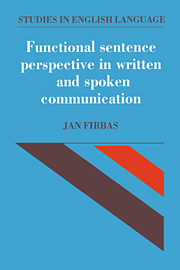Book contents
- Frontmatter
- Contents
- Preface
- List of abbreviations
- Part I Functional sentence perspective in written communication
- 1 Introduction
- 2 The sentence and the carriers of communicative dynamism
- 3 The contextual factor
- 4 The semantic factor
- 5 The theme and the non-theme
- 6 Some special issues of the theory of functional sentence perspective
- 7 Word order and functional sentence perspective
- Part II Functional sentence perspective in spoken communication
- References
- Index
7 - Word order and functional sentence perspective
Published online by Cambridge University Press: 19 November 2009
- Frontmatter
- Contents
- Preface
- List of abbreviations
- Part I Functional sentence perspective in written communication
- 1 Introduction
- 2 The sentence and the carriers of communicative dynamism
- 3 The contextual factor
- 4 The semantic factor
- 5 The theme and the non-theme
- 6 Some special issues of the theory of functional sentence perspective
- 7 Word order and functional sentence perspective
- Part II Functional sentence perspective in spoken communication
- References
- Index
Summary
Word order as a system
The preceding chapters have demonstrated that in the interplay of the FSP factors determining the distribution of CD over the written sentence, linear modification manifests itself – if not worked counter to by the contextual factor and/or the semantic factor – through the actual linear arrangement of the elements. In this way it asserts itself as an important factor (principle) of word order. This raises the problem of the relationship between word order and FSP. This problem will be taken up by the present chapter. Let me first offer a few thoughts on word order in general and word-order principles in particular.
The literature on word order is extensive, but of specific relevance to my research is Mathesius' view that word order is a system constituted by the mutual relations of word-order principles (Mathesius 1942; 1975; 153–63). These principles are essentially valid for all Indo–European languages and possibly even for languages outside the Indo–European sphere, but may differ in the extent of their operation from language to language, or even from one period to another in the development of one particular language. Like other systems of language, the system of word order is not viewed as closed and perfectly balanced. Mathesius emphasizes that the word-order system of a language can be understood in a more comprehensive way if it is compared with that of another language, preferably one of different structure. He refers to this approach as the method of analytical comparison (Mathesius 1936: 95).
- Type
- Chapter
- Information
- Publisher: Cambridge University PressPrint publication year: 1992



